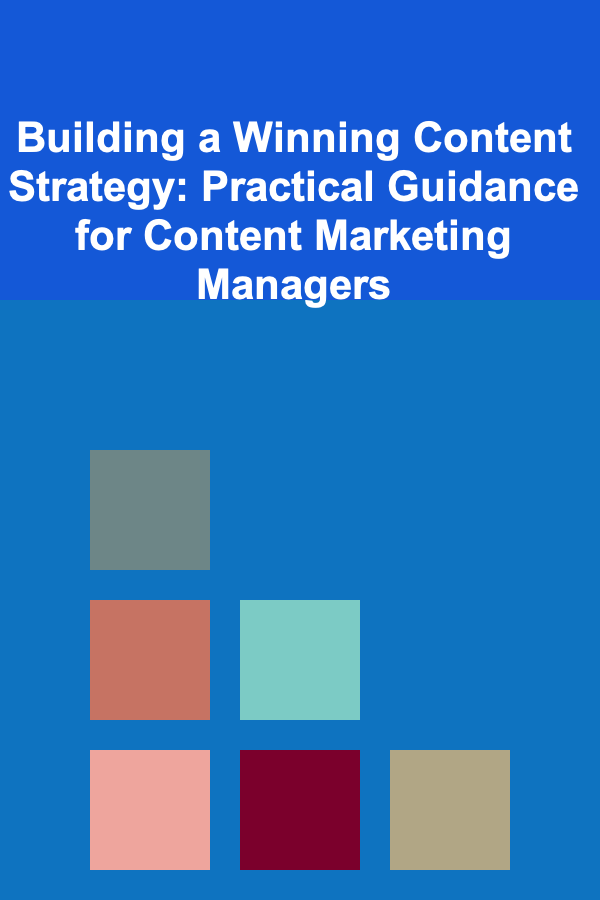
Building a Winning Content Strategy: Practical Guidance for Content Marketing Managers
ebook include PDF & Audio bundle (Micro Guide)
$12.99$11.99
Limited Time Offer! Order within the next:

In today's fast-paced digital world, content is king---but only when it's crafted strategically. Whether you're a seasoned content marketing manager or just stepping into the role, creating a winning content strategy requires thoughtful planning, consistent execution, and continuous optimization. This actionable guide will provide you with a step-by-step approach to building a content strategy that not only attracts and engages your audience but also drives measurable business results.
Understanding the Role of a Content Strategy
Before diving into the specifics, it's crucial to understand what a content strategy is and why it's important.
A content strategy is a long-term plan for creating, distributing, and measuring content that aligns with your business goals, meets your audience's needs, and drives engagement. In simpler terms, it's the blueprint for all your content efforts, ensuring they work together cohesively to achieve the desired outcomes.
Your strategy should focus on:
- Brand Awareness: Making your brand recognizable to new audiences.
- Lead Generation: Nurturing potential customers towards conversion.
- Customer Retention: Creating content that keeps existing customers loyal.
- SEO and Organic Growth: Using content to improve search rankings and attract organic traffic.
- Sales Enablement: Supporting the sales team with content that helps close deals.
By aligning your content strategy with broader business goals, you ensure that your efforts are not only creative but also result-driven.
Defining Your Content Marketing Goals
No content strategy can succeed without clear, measurable goals. The first step in building your content strategy is to define your objectives. These should be aligned with your company's overarching goals and address key performance indicators (KPIs) relevant to your business.
Some common goals include:
- Increase Brand Awareness: If you want to increase visibility, your content might focus on high-level, informative pieces that educate your audience about your industry, products, or services.
- Generate Leads: For lead generation, your content should focus on capturing the interest of potential customers and offering valuable resources in exchange for contact information.
- Engage and Retain Customers: Retention-focused content should build relationships with your audience and encourage ongoing engagement, turning one-time buyers into loyal customers.
- Boost Sales and Conversions: Content that nurtures leads, showcases products, or includes clear calls to action (CTAs) can guide prospects toward making a purchase.
Setting SMART Goals
To ensure your goals are actionable and achievable, apply the SMART framework:
- Specific: Define exactly what you want to accomplish.
- Measurable: Determine how you will measure success (e.g., traffic, leads, sales).
- Achievable: Set realistic goals based on resources, time, and capabilities.
- Relevant: Ensure your goals align with your overall business objectives.
- Time-Bound: Set deadlines to keep the team focused and on track.
SMART goals provide clarity and direction, helping your content marketing efforts stay aligned with business priorities.
Understanding Your Audience
An effective content strategy is rooted in deep audience understanding. If you don't know your audience's needs, pain points, and preferences, your content will miss the mark. That's why the next step is thorough audience research.
Create Detailed Buyer Personas
Buyer personas are semi-fictional representations of your ideal customers, based on data and research. These personas should include information like:
- Demographics: Age, gender, job title, location, etc.
- Behavioral Insights: Online habits, preferred content types, and social media platforms.
- Pain Points and Needs: What challenges does your audience face, and how can your product or service solve them?
- Goals and Motivations: What does your audience want to achieve? What drives their purchasing decisions?
Creating buyer personas helps tailor your content to resonate with your target audience and guide them through the buyer's journey.
Use Data for Insights
In addition to creating personas, leverage analytics tools and customer feedback to gather valuable insights. Google Analytics, social media insights, and email marketing platforms can provide valuable data on your audience's behavior and engagement. Track metrics like:
- Website traffic (volume, sources)
- Social media engagement (likes, shares, comments)
- Email open and click-through rates
- Conversion rates (downloads, sign-ups, purchases)
These insights will allow you to refine your content and make informed decisions about where to focus your efforts.
Aligning Content With the Buyer's Journey
Your audience isn't just one monolithic group; they are at various stages of the buyer's journey, and your content should speak to their specific needs at each stage. The buyer's journey is typically divided into three stages: Awareness, Consideration, and Decision.
Awareness Stage: Attracting the Right Audience
At this stage, potential customers are just becoming aware of their problems and are searching for general information. They might not even know your brand exists. Your content here should focus on educating and raising awareness.
- Content Types: Blog posts, educational videos, infographics, podcasts, social media posts.
- Content Goals: Inform, educate, and engage.
- Examples: "What is [problem] and How to Solve It?", "Top 10 Industry Trends You Should Know," or "Beginner's Guide to [Topic]."
Consideration Stage: Establishing Thought Leadership
As your audience moves into the consideration stage, they are actively researching solutions to their problems. They're aware of their needs and are comparing different options. Content here should provide in-depth insights and build trust.
- Content Types: Case studies, white papers, webinars, product comparison guides.
- Content Goals: Provide solutions, demonstrate expertise, build trust.
- Examples: "How Our Product Solves [Problem]," "Case Study: How We Helped [Company] Achieve [Result]," or "5 Ways to Evaluate [Solution Type]."
Decision Stage: Converting Leads Into Customers
In this final stage, your audience is ready to make a decision. Your content should focus on helping them take the leap into purchasing. Be direct, clear, and persuasive.
- Content Types: Product demos, testimonials, free trials, pricing pages.
- Content Goals: Drive conversions, clarify objections, and provide final incentives.
- Examples: "Get Started Today with a Free Trial," "See How Our Product Helps [Customer]," or "Customer Testimonials."
By aligning content with the buyer's journey, you ensure that each piece serves a specific purpose and speaks directly to the needs of your audience.
Crafting High-Quality, Engaging Content
Creating high-quality content is essential to attracting and retaining your audience. But what makes content truly engaging?
Know Your Audience's Preferred Content Format
Different types of content appeal to different segments of your audience. For example:
- Long-form content (e.g., blog posts, guides) is great for educating your audience and ranking on search engines.
- Visual content (e.g., infographics, videos, and social media posts) is highly shareable and great for quick engagement.
- Interactive content (e.g., quizzes, surveys) can increase user interaction and provide valuable data.
Tell Compelling Stories
People remember stories more than facts and figures. Incorporate storytelling into your content to make it more relatable and human. Share customer success stories, behind-the-scenes narratives, or your brand's journey to create an emotional connection.
Provide Actionable Takeaways
Your content should always provide value. Offer practical, actionable advice that your audience can implement right away. Whether it's a quick tip, step-by-step guide, or resource list, make sure every piece of content delivers tangible value.
Content Distribution: Getting Your Message Out
Creating high-quality content is only half the battle; distributing it effectively is just as important. To ensure your content reaches the right audience, use a mix of owned, earned, and paid media channels.
Owned Media
Owned media refers to the channels you control, such as your website, blog, and email list. These are your primary assets for distributing content. Ensure your website is optimized for SEO and provides a seamless user experience.
- Blog: Use your blog to regularly post relevant content, optimize it for SEO, and drive organic traffic.
- Email Newsletter: Use email to share curated content, updates, and exclusive offers directly with your audience.
- Social Media: Use platforms like LinkedIn, Facebook, Twitter, and Instagram to share and promote content and engage with your audience.
Earned Media
Earned media refers to content or coverage you receive as a result of your brand's efforts. This could be social shares, backlinks, or media mentions. Focus on building relationships with influencers, journalists, and industry leaders to earn credibility and extend your reach.
Paid Media
Paid media includes sponsored posts, display ads, or promoted content. Use paid media to amplify your content's reach and target specific audience segments.
Measuring Success and Optimizing Content Strategy
To continually improve your content strategy, it's essential to measure performance and optimize based on data.
Key Metrics to Track
- Engagement Metrics: Likes, shares, comments, time on page.
- Lead Generation Metrics: Sign-ups, downloads, form submissions.
- SEO Metrics: Organic traffic, keyword rankings, backlink quantity.
- Conversion Metrics: Sales, click-through rates, ROI.
A/B Testing
Test different variations of your content, headlines, CTAs, and distribution strategies. A/B testing can reveal what resonates most with your audience, helping you refine your approach and optimize future campaigns.
Continuous Improvement
Content marketing is an ongoing process. Use the insights gained from performance metrics and audience feedback to tweak your strategy and improve the quality and effectiveness of your content over time.
Conclusion
Building a winning content strategy is not a one-time task but an ongoing process that requires careful planning, execution, and optimization. By setting clear goals, understanding your audience, crafting engaging content, and using data to drive decisions, you can create a content strategy that delivers long-term results. With consistency and commitment, your content can become a powerful tool that drives brand growth, engages your audience, and ultimately contributes to business success.
Reading More From Our Other Websites
- [Organization Tip 101] How to Choose the Right Tiles for a Beautiful Herringbone Design
- [Home Security 101] How to Improve Your Home's Security Without Breaking the Bank
- [Home Security 101] How to Set Up Motion-Sensor Lighting Around Your Home
- [Toy Making Tip 101] From Sketch to Fun: Step‑by‑Step Toy Making Strategies
- [Organization Tip 101] How to Use Magnetic Strips for Storing Metal Jewelry Pieces
- [Toy Making Tip 101] Best Eco‑Friendly Materials for Hand‑Crafted Wooden Toys: A Complete Guide
- [Organization Tip 101] How to Create a System for Managing Digital Receipts
- [Personal Care Tips 101] How to Improve Your Posture to Reduce Back Pain
- [Home Budget 101] How to Budget for Groceries: Save Money Without Sacrifice
- [Home Staging 101] How to Stage Your Home's Entryway to Make a Great First Impression

How to Create a Cozy Pet Sleeping Area at Home
Read More
How to Make Use of Overhead Storage in Garages
Read More
Maximizing Your Earnings with Passive Income from Deep Learning
Read More
How to Get Started with White Water Rafting
Read More
Dating with Purpose and Intention: Building Meaningful Connections
Read MoreOther Products

How to Create a Cozy Pet Sleeping Area at Home
Read More
How to Make Use of Overhead Storage in Garages
Read More
Maximizing Your Earnings with Passive Income from Deep Learning
Read More
How to Get Started with White Water Rafting
Read More